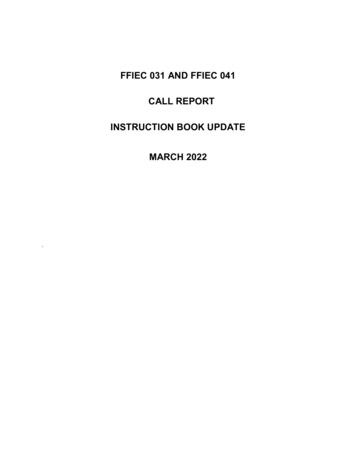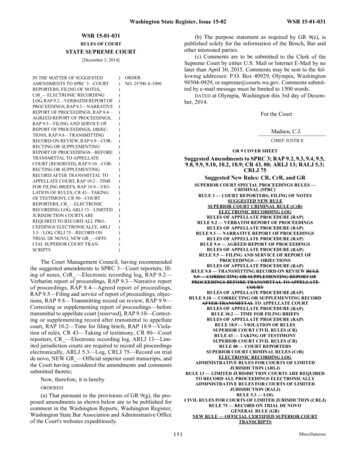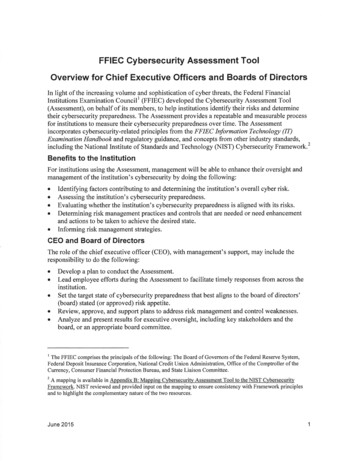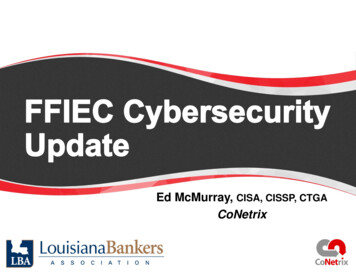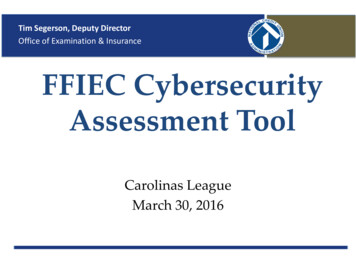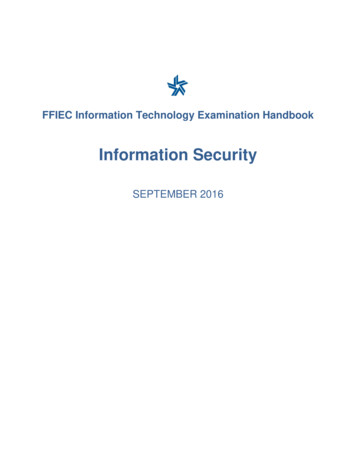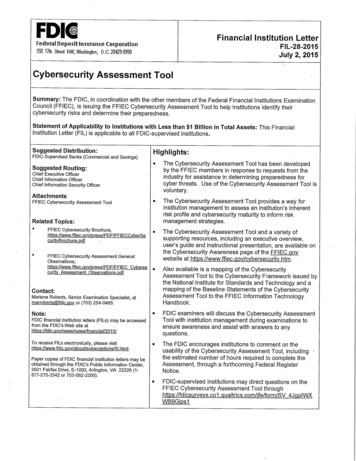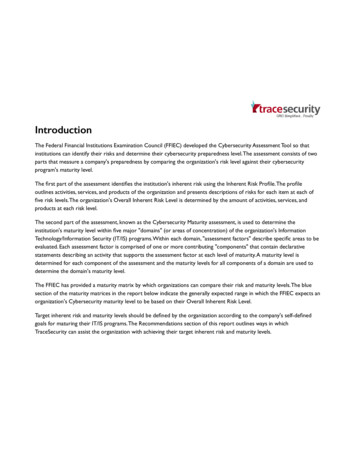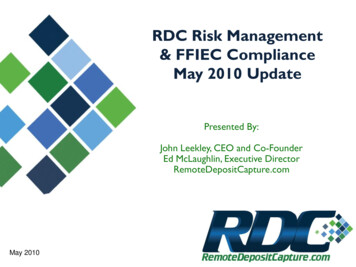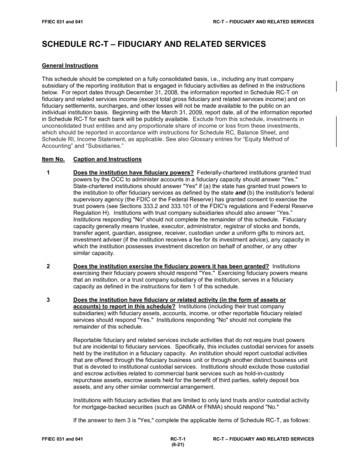
Transcription
FFIEC 031 and 041RC-T – FIDUCIARY AND RELATED SERVICESSCHEDULE RC-T – FIDUCIARY AND RELATED SERVICESGeneral InstructionsThis schedule should be completed on a fully consolidated basis, i.e., including any trust companysubsidiary of the reporting institution that is engaged in fiduciary activities as defined in the instructionsbelow. For report dates through December 31, 2008, the information reported in Schedule RC-T onfiduciary and related services income (except total gross fiduciary and related services income) and onfiduciary settlements, surcharges, and other losses will not be made available to the public on anindividual institution basis. Beginning with the March 31, 2009, report date, all of the information reportedin Schedule RC-T for each bank will be publicly available. Exclude from this schedule, investments inunconsolidated trust entities and any proportionate share of income or loss from these investments,which should be reported in accordance with instructions for Schedule RC, Balance Sheet, andSchedule RI, Income Statement, as applicable. See also Glossary entries for “Equity Method ofAccounting” and “Subsidiaries.”Item No.Caption and Instructions1Does the institution have fiduciary powers? Federally-chartered institutions granted trustpowers by the OCC to administer accounts in a fiduciary capacity should answer "Yes."State-chartered institutions should answer "Yes" if (a) the state has granted trust powers tothe institution to offer fiduciary services as defined by the state and (b) the institution's federalsupervisory agency (the FDIC or the Federal Reserve) has granted consent to exercise thetrust powers (see Sections 333.2 and 333.101 of the FDIC's regulations and Federal ReserveRegulation H). Institutions with trust company subsidiaries should also answer “Yes.”Institutions responding "No" should not complete the remainder of this schedule. Fiduciarycapacity generally means trustee, executor, administrator, registrar of stocks and bonds,transfer agent, guardian, assignee, receiver, custodian under a uniform gifts to minors act,investment adviser (if the institution receives a fee for its investment advice), any capacity inwhich the institution possesses investment discretion on behalf of another, or any othersimilar capacity.2Does the institution exercise the fiduciary powers it has been granted? Institutionsexercising their fiduciary powers should respond "Yes." Exercising fiduciary powers meansthat an institution, or a trust company subsidiary of the institution, serves in a fiduciarycapacity as defined in the instructions for item 1 of this schedule.3Does the institution have fiduciary or related activity (in the form of assets oraccounts) to report in this schedule? Institutions (including their trust companysubsidiaries) with fiduciary assets, accounts, income, or other reportable fiduciary relatedservices should respond "Yes." Institutions responding "No" should not complete theremainder of this schedule.Reportable fiduciary and related services include activities that do not require trust powersbut are incidental to fiduciary services. Specifically, this includes custodial services for assetsheld by the institution in a fiduciary capacity. An institution should report custodial activitiesthat are offered through the fiduciary business unit or through another distinct business unitthat is devoted to institutional custodial services. Institutions should exclude those custodialand escrow activities related to commercial bank services such as hold-in-custodyrepurchase assets, escrow assets held for the benefit of third parties, safety deposit boxassets, and any other similar commercial arrangement.Institutions with fiduciary activities that are limited to only land trusts and/or custodial activityfor mortgage-backed securities (such as GNMA or FNMA) should respond "No."If the answer to item 3 is "Yes," complete the applicable items of Schedule RC-T, as follows:FFIEC 031 and 041RC-T-1(6-21)RC-T – FIDUCIARY AND RELATED SERVICES
FFIEC 031 and 041RC-T – FIDUCIARY AND RELATED SERVICESItem No.3(cont.)Caption and InstructionsInstitutions with total fiduciary assets (item 10, sum of columns A and B) greater than 250 million (as of the preceding December 31) or with gross fiduciary and related servicesincome greater than 10 percent of revenue (net interest income plus noninterest income) forthe preceding calendar year must complete: Items 4 through 22 on the FFIEC 041 quarterly; items 4 through 22.a on the FFIEC 031quarterly;Items 23 through 26 annually with the December report;Memorandum item 3 quarterly; andMemorandum items 1, 2, and 4 annually with the December report.Institutions with total fiduciary assets (item 10, sum of columns A and B) of less than or equalto 250 million (as of the preceding December 31) that do not meet the fiduciary income testfor quarterly reporting must complete: Items 4 through 13 annually with the December report; andMemorandum items 1 through 3 annually with the December report.In addition, institutions with total fiduciary assets greater than 100 million but less than orequal to 250 million (as of the preceding December 31) that do not meet the fiduciaryincome test for quarterly reporting must also complete Memorandum item 4 annually with theDecember report.Fiduciary and Related AssetsInstitutions should generally report fiduciary and related assets using their market value as of the reportdate. While market value quotations are readily available for marketable securities, many financial andphysical assets held in fiduciary accounts are not widely traded or easily valued. If the methodology fordetermining market values is not set or governed by applicable law (including the terms of the prevailingfiduciary agreement), the institution may use any reasonable method to establish values for fiduciary andrelated assets for purposes of reporting on this schedule. Reasonable methods include appraised values,book values, or reliable estimates. Valuation methods should be consistent from reporting period toreporting period. This "reasonable method" approach to reporting market values applies both to financialassets that are not marketable and to physical assets. Common physical assets held in fiduciaryaccounts include real estate, equipment, collectibles, and household goods.Only those Individual Retirement Accounts, Keogh Plan accounts, Health Savings Accounts, and similaraccounts offered through a fiduciary business unit of the reporting institution should be reported inSchedule RC-T. When such accounts are not offered through an institution’s fiduciary business unit, theyshould not be reported in Schedule RC-T. Accounts that consist solely of deposits in the bank itself shouldnot be reported in Schedule RC-T.If two institutions are named co-fiduciary in the governing instrument, both institutions should report theaccount. In addition, where one institution contracts with another for fiduciary or related services(i.e., Bank A provides custody services to the trust accounts of Bank B, or Bank A provides investmentmanagement services to the trust accounts of Bank B), both institutions should report the accounts intheir respective capacities.Exclude unfunded insurance trusts, testamentary executor appointments, and any other arrangementsrepresenting potential future fiduciary accounts.Asset values reported on this schedule should generally exclude liabilities. For example, an employeebenefit account with associated loans against account assets should be reported gross of the outstandingFFIEC 031 and 041RC-T-2(6-21)RC-T – FIDUCIARY AND RELATED SERVICES
FFIEC 031 and 041RC-T – FIDUCIARY AND RELATED SERVICESFiduciary and Related Assets (cont.)loan balances. As another example, an account with a real estate asset and corresponding mortgageloan should be reported gross of the mortgage liability. However, there are two exceptions. First, forpurposes of this schedule, overdrafts should be netted against gross fiduciary assets. Second, the fairvalue of derivative instruments, as defined in ASC Topic 815, Derivatives and Hedging should beincluded in (i.e., netted against) gross assets even if the fair value is negative.Securities borrowing/lending transactions should be reflected as sales or as secured borrowingsaccording to ASC Topic 860, Transfers and Servicing. A transferee ("borrower") of securities generally isrequired to provide "collateral" to the transferor ("lender") of securities. When such transactions do notqualify as sales, securities "lenders" and "borrowers" should account for the transactions as securedborrowings in which cash (or securities that the holder is permitted by contract or custom to sell orrepledge) received as "collateral" by the securities "lender" is considered the amount borrowed and thesecurities "loaned" are considered pledged against the amount borrowed. For purposes of this schedule,securities held in fiduciary accounts that are "loaned" in securities lending transactions (that areaccounted for as secured borrowings) should be reported as an asset of the fiduciary account that“loaned” the securities, but the “collateral” received should not also be reported as an asset of thisfiduciary account.In the Fiduciary and Related Assets section, the market value of Collective Investment Fund (CIF) unitsshould be reported along with individual participant accounts in the Column and Item that corresponds toeach participant. The aggregate amount of a CIF that is operated by an institution should NOT also bereported as a separate, additional account in the Fiduciary and Related Assets section of this schedule. Institutions that are fiduciaries or exercise fiduciary powers as defined in the “General Instructions”section for Schedule RC-T, item 1, must include all investment management and investment advisoryaccounts and assets administered by the institution directly or administered by entities to whom theinstitution has delegated its investment authority. However, an investment advisor registered with theSecurities and Exchange Commission (SEC) under the Investment Advisors Act of 1940 or registeredwith a state agency (registered investment advisors) is not a fiduciary nor does it exercise fiduciarypowers as defined in the “General Instructions” section for Schedule RC-T, item 1. Therefore, institutionsshould not include investment management and investment advisory accounts and assets administeredby registered investment advisory subsidiaries of the institution, except when:The institution fiduciary is the investment manager or advisor, but has delegated investment managementor advisory responsibilities to the subsidiary registered investment advisor, orAn institution is administering the account in a fiduciary capacity, as defined in the instructions for item 1above, but the governing instrument assigns direct responsibility for investment management to theregistered investment advisor.Managed Assets – Column AReport the total market value of assets held in managed fiduciary accounts. An account should becategorized as managed if the institution has investment discretion over the assets of the account.Investment discretion is defined as the sole or shared authority (whether or not that authority is exercised)to determine what securities or other assets to purchase or sell on behalf of the fiduciary related account.An institution that delegates its authority over investments and an institution that receives delegatedauthority over investments are BOTH deemed to have investment discretion.Therefore, whether an account where investment management has been delegated to a registeredinvestment adviser, whether affiliated or unaffiliated with the reporting institution, should be reported as amanaged account depends on whether the delegation of investment authority to the registeredinvestment adviser was made pursuant to the exercise of investment discretion by the reportinginstitution. If so, the account is deemed to be a managed account by the reporting institution. Otherwise,the account would be a non-managed account for purposes of Schedule RC-T.An entire account should be reported as either managed or non-managed based on the predominantresponsibility of the reporting institution.FFIEC 031 and 041RC-T-3(6-21)RC-T – FIDUCIARY AND RELATED SERVICES
FFIEC 031 and 041RC-T – FIDUCIARY AND RELATED SERVICESFiduciary and Related Assets (cont.)Non-Managed Assets – Column BReport the total market value of assets held in non-managed fiduciary accounts. An account should becategorized as non-managed if the institution does not have investment discretion. Those accounts forwhich the institution provides a menu of investment options but the ultimate selection authority remainswith the account holder or an external manager should be categorized as non-managed. For example,an institution that offers a choice of sweep vehicles is not necessarily exercising investment discretion.The process of narrowing investment options from a range of alternatives does not create a managedfiduciary account for the purposes of this schedule. For example, a 401(k) employee benefit plan wherethe participants select investments from a list of investment options should be reported as non-managedfor the purposes of this schedule.Number of Managed Accounts – Column CReport the total number of managed fiduciary accounts.Number of Non-Managed Accounts – Column DReport the total number of non-managed fiduciary accounts.Item No.Caption and Instructions4Personal trust and agency accounts. Report the market value and number of accounts forall testamentary trusts, revocable and irrevocable living trusts, other personal trusts, andnon-managed personal agency accounts. Include accounts in which the institution serves asexecutor, administrator, guardian, or conservator. Exclude personal investment managementand investment advisory agency accounts, which should be reported in Schedule RC-T,item 7. Also exclude Keogh Plan accounts, Individual Retirement Accounts (IRAs), HealthSavings Accounts, and other pension or profit-sharing plans for self-employed individuals,which should be reported in Schedule RC-T, item 5. Personal accounts that are solelycustody or safekeeping should be reported in item 11 of this schedule.5Employee benefit and retirement-related trust and agency accounts:5.aEmployee benefit – defined contribution. Report the market value and number ofaccounts for all employee benefit defined contribution accounts in which the institution servesas either trustee or agent. Include 401(k) plans, 403(b) plans, profit-sharing plans, moneypurchase plans, target benefit plans, stock bonus plans, employee stock ownership plans,and thrift savings plans. Employee benefit accounts for which the institution serves as adirected trustee should be reported as non-managed. The number of accounts reportedshould reflect the total number of plans administered rather than the number of planparticipants. Employee benefit accounts that are solely custody and safekeeping accountsshould be reported in Schedule RC-T, item 11.5.bEmployee benefit – defined benefit. Report the market value and number of accounts forall employee benefit defined benefit plans in which the institution serves as either trustee oragent. Employee benefit accounts for which the institution serves as a directed trusteeshould be reported as non-managed. The number of accounts reported should reflect thetotal number of plans administered rather than the number of plan participants. Employeebenefit accounts that are solely custody and safekeeping accounts should be reported inSchedule RC-T, item 11.5.cOther employee benefit and retirement-related accounts. Report the market value andnumber of accounts for all other employee benefit and retirement-related fiduciary accountsin which the institution serves as trustee or agent. Include Keogh Plan accounts, IndividualRetirement Accounts, Health Savings Accounts, Medical Savings Accounts, and otherFFIEC 031 and 041RC-T-4(6-21)RC-T – FIDUCIARY AND RELATED SERVICES
FFIEC 031 and 041RC-T – FIDUCIARY AND RELATED SERVICESItem No.Caption and Instructions5.c(cont.)pension or profit-sharing plans for self-employed individuals. Also report the market value ofassets and the number of accounts for employee welfare benefit trusts and agencies.Employee welfare benefit plans include plans, funds, or programs that provide medical,surgical, or hospital care benefits; benefits in the event of sickness, accident, disability, death,or unemployment; vacation benefits; apprenticeship or other training programs; day carecenters; scholarship funds; or prepaid legal services. Employee benefit accounts for whichthe institution serves as a directed trustee should be reported as non-managed. Excludeaccounts, originated by fiduciary or non-fiduciary personnel, that are only permittedto be invested in own-bank deposits. The number of accounts reported should reflect thetotal number of plans or accounts administered rather than the number of plan participants.Other retirement accounts that are solely custody and safekeeping accounts should bereported in Schedule RC-T, item 11. Individual Retirement Accounts, Health SavingsAccounts, and other similar accounts should also be reported in Schedule RC-T, item 13.6Corporate trust and agency accounts. Report the market value of assets held by theinstitution for all corporate trust and agency accounts. Report assets that are theresponsibility of the institution to manage or administer in accordance with the corporate trustagreement. Include assets relating to unpresented bonds or coupons relating to issues thathave been called or matured. Do NOT report the entire market value of the associatedsecurities or the outstanding principal of associated debt issues. Include accounts for whichthe institution is trustee for corporate securities, tax-exempt and other municipal securities,and other debt securities including unit investment trusts. Also include accounts for which theinstitution is dividend or interest paying agent, and any other type of corporate trustee oragent appointment. Accounts that are solely custodial or safekeeping should be reported inSchedule RC-T, item 11.7Investment management and investment advisory agency accounts. Report the marketvalue and number of accounts for all individual and institutional investment management andinvestment advisory agency accounts that are administered within the fiduciary area of theinstitution. Investment management accounts are those agency accounts for which theinstitution has investment discretion; however, title to the assets remains with the client.Include accounts for which the institution serves as a sub-advisor. Investment advisoryaccounts are those agency accounts for which the institution provides investment advice for afee, but for which some other person is responsible for investment decisions. Investmentmanagement agency accounts should be reported as managed. Investment advisory agencyaccounts should be reported as non-managed. Investment management and investmentadvisory agency accounts maintained for foundations and endowments should be reported inSchedule RC-T, item 8. As noted the Fiduciary and Related Assets section above, excludeinvestment management and investment advisory agency accounts that are administered bysubsidiary registered investment advisors. Include those mutual funds that are advised bythe fiduciary area that is a separately identifiable department or division (as defined inSection 217 of the Gramm-Leach-Bliley Act). Classes of the same mutual fund should becombined and reported as a single account.8Foundation and endowment trust and agency accounts. Report the market value andnumber of accounts for all foundations and endowments (whether established by individuals,families, corporations, or other entities) that file any version of Form 990 with the InternalRevenue Service and for which the institution serves as either trustee or agent. Also includethose foundations and endowments that do not file Form 990, 990EZ, or 990PF solelybecause the organization’s gross receipts or total assets fall below reporting thresholds, butwould otherwise be required to file. Foundations and endowments established by churches,which are exempt from filing Form 990, should also be included in this item. Employeebenefit accounts maintained for a foundation’s or endowment’s employees should beFFIEC 031 and 041RC-T-5(6-21)RC-T – FIDUCIARY AND RELATED SERVICES
FFIEC 031 and 0418(cont.)RC-T – FIDUCIARY AND RELATED SERVICESreported in Schedule RC-T, item 5. Accounts that are solely custodial or safekeeping shouldbe reported in Schedule RC-T, item 11.9Other fiduciary accounts. Report the market value and number of accounts for all othertrusts and agencies not reported in Schedule RC-T, items 4 through 8. Custody andsafekeeping accounts should be reported in Schedule RC-T, item 11.10Total fiduciary accounts. Report the sum of items 4 through 9.Item No.11Caption and InstructionsCustody and safekeeping accounts. Report the market value and number of accounts forall personal and institutional custody and safekeeping accounts held by the institution.Safekeeping and custody accounts are a type of agency account in which the reportinginstitution performs one or more specified agency functions but the institution is not a trusteeand also is not responsible for managing the asset selection for account assets. Theseagency services may include holding assets, processing income and redemptions, and otherrecordkeeping and customer reporting services. For employee benefit custody orsafekeeping accounts, the number of accounts reported should reflect the total number ofplans administered rather than the number of plan participants. Include accounts in whichthe institution serves in a sub-custodian capacity. For example, where one institutioncontracts with another for custody services, both institutions should report the accounts intheir respective capacity. Individual Retirement Accounts, Health Savings Accounts, andother similar accounts should also be reported in Schedule RC-T, item 13.Accounts in which the institution serves as trustee or in an agency capacity in addition tobeing custodian should be reported in the category of the primary relationship. For example,personal trust accounts in which the institution also serves as custodian should be reportedas personal trust accounts and not as custodian accounts. An institution should report anaccount only once in Schedule RC-T, items 4 through 9 and 11.Report custodian accounts that are incidental to fiduciary services. Include those custodyand safekeeping accounts that are administered by the trust department, and those that areadministered in other areas of the institution through an identifiable business unit that focuseson offering fiduciary related custodial services to institutional clients. Exclude those custodialand escrow activities related to commercial bank services such as hold-in-custodyrepurchase assets, securities safekeeping services for correspondent banks, escrow assetsheld for the benefit of third parties, safety deposit box assets, and any other similarcommercial arrangement.NOTE: Item 12 is applicable only to banks filing the FFIEC 031 report form.12Fiduciary accounts held in foreign offices. Report the market value and number ofaccounts included in Schedule RC-T, items 10 and 11, above that are attributable toaccounts held in foreign offices.13Individual Retirement Accounts, Health Savings Accounts, and other similar accounts.Report the market value and number of Individual Retirement Accounts, Health SavingsAccounts, and other similar accounts included in Schedule RC-T, items 5.c and 11. Othersimilar accounts include Roth IRAs, Coverdell Education Savings Accounts, and ArcherMedical Savings Accounts. Exclude Keogh Plan accounts.FFIEC 031 and 041RC-T-6(6-21)RC-T – FIDUCIARY AND RELATED SERVICES
FFIEC 031 and 041RC-T – FIDUCIARY AND RELATED SERVICESFiduciary and Related Services IncomeThe income categories in Schedule RC-T, items 14 through 20, correspond to the fiduciary assetcategories described in Schedule RC-T, items 4 through 11, above. For a detailed definition of thecategories, please refer to the corresponding account descriptions. Income and expenses should bereported on an accrual basis. Institutions may report income and expense accounts on a cash basis if theresults would not materially differ from those obtained using an accrual basis. For report dates throughDecember 31, 2008, the information reported in Schedule RC-T on fiduciary and related services income(except total gross fiduciary and related services income) will not be made available to the public on anindividual institution basis. Beginning with the March 31, 2009, report date, all of the information reportedin Schedule RC-T for each bank will be publicly available.Fiduciary and related services income should be reported on a gross basis in Schedule RC-T, items 14through 22. Net fiduciary settlements, surcharges, and other losses should be reported on a net basis inSchedule RC-T, item 24, and in Schedule RI, item 7.d, “Other noninterest expense.” Net losses are grosslosses less recoveries (including those from insurance payments). If the institution enters into a “feereduction” or “fee waiver” agreement with a client as the method for reimbursing or compensating theclient for a loss on the client’s fiduciary or related services account arising from an error, misfeasance, ormalfeasance, the full amount of this loss must be recognized on an accrual basis and included inSchedule RC-T, item 24, and in the appropriate subitem and column of Schedule RC-T, Memorandumitem 4. An institution should not report such a loss as a reduction of the gross income from fiduciary andrelated services it reports in Schedule RC-T, items 14 through 22, and Schedule RI, item 5.a, “Incomefrom fiduciary activities,” in the current or future periods when the “fee reduction” or “fee waiver” takesplace. (See the example after the instructions to Schedule RC-T, Memorandum item 4.e.)FFIEC 031 and 041RC-T-6a(6-21)RC-T – FIDUCIARY AND RELATED SERVICES
This page intentionally left blank.
FFIEC 031 and 041Item No.RC-T – FIDUCIARY AND RELATED SERVICESCaption and Instructions14Personal trust and agency accounts. Report gross income generated from personal trustand agency accounts as defined for item 4 of this schedule.15Employee benefit and retirement-related trust and agency accounts:15.aEmployee benefit – defined contribution. Report gross income generated from definedcontribution employee benefit trust and agency accounts as defined for item 5.a of thisschedule.15.bEmployee benefit – defined benefit. Report gross income generated from defined benefitemployee benefit trust and agency accounts as defined for item 5.b of this schedule.15.cOther employee benefit and retirement-related accounts. Report gross incomegenerated from other employee benefit and retirement-related accounts as defined foritem 5.c of this schedule.16Corporate trust and agency accounts. Report gross income generated from corporatetrust and agency relationships as defined for item 6 of this schedule.17Investment management and investment advisory agency accounts. Report grossincome generated from investment management and investment advisory agency accountsas defined for item 7 of this schedule. Also include income generated from investmentadvisory activities when the assets are not held by the institution.18Foundation and endowment trust and agency accounts. Report gross income generatedfrom foundation and endowment trust and agency accounts as defined for item 8 of thisschedule.19Other fiduciary accounts. Report gross income generated from other trust and agencyaccounts as defined for item 9 of this schedule.20Custody and safekeeping accounts. Report gross income generated from custody andsafekeeping agency accounts as defined for item 11 of this schedule.21Other fiduciary and related services income. Report all other gross fiduciary relatedincome that cannot properly be reported in Schedule RC-T, items 14 through item 20, above.Include income received from others (including affiliates) for fiduciary and related servicesprovided by the institution. Income received from investment advisory services in which theaccount assets are held in a custody or safekeeping account at the reporting institutionshould be reported in item 17 of this schedule. Also include net income generated fromsecurities lending activities (i.e., after broker rebates and income paid to lending accounts).Include income from custodial activities for land trusts and mortgage-backed securities.Exclude allocations of income to the trust department from other areas of the institution suchas credits for fiduciary cash held as a deposit in the commercial bank.22Total gross fiduciary and related services income. Report the sum of items 14through 21. This item must equal Schedule RI, item 5.a, “Income from fiduciary activities.”FFIEC 031 and 041RC-T-7(12-14)RC-T – FIDUCIARY AND RELATED SERVICES
FFIEC 031 and 041Item No.RC-T – FIDUCIARY AND RELATED SERVICESCaption and InstructionsNOTE: Item 22.a is applicable only to banks filing the FFIEC 031 report form.22.aFiduciary and related services income – foreign offices. Report the total amount offiduciary and related services income included in Schedule RC-T, item 22, above that isattributable to fiduciary accounts held in foreign offices.23Less: Expenses. Report total direct and indirect expenses attributable to the fiduciary andrelated services reported in this schedule. Include salaries, wages, bonuses, incentive pay,and employee benefits for employees assigned to reportable activities. If only a portion oftheir time is allocated to reportable activities, report that proportional share of their salariesand employee benefits.
FFIEC 031 and 041 RC-T - FIDUCIARY AND RELATED SERVICES . FFIEC 031 and 041 RC-T-3 RC-T - FIDUCIARY AND RELATED SERVICES (6-21) Fiduciary and Related Assets (cont.) loan balances. As another example, an account with a real estate asset and corresponding mortgage loan should be reported gross of the mortgage liability.
